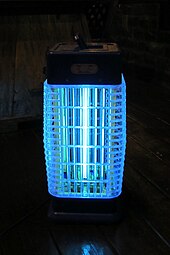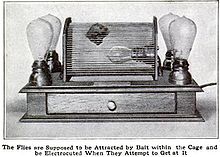Bug zapper

A bug zapper, more formally called an electrical discharge insect control system, electric insect killer or (insect) electrocutor trap, is a device that attracts and kills flying
Description

Bug zappers are usually housed in a protective cage of plastic or grounded metal bars to prevent people or larger animals from touching the high voltage grid. A light source is fitted inside, often a
A high-voltage
Many bug zappers are fitted with trays that collect the electrocuted insects; other models are designed to allow the debris to fall to the ground below. Some use a fan to help to trap the insect.
Indoors or outdoors use
Bug zapper traps may be installed indoors, or outdoors if they are constructed to withstand the effects of weather.
However, they are not effective at killing biting insects (female
Mosquitoes are attracted to
Scattering
Research has shown that when insects are
The
Hand-held type
Battery-powered bug zappers are manufactured, often in the shape of a
History

In its October 1911 issue, Popular Mechanics magazine had a piece showing a model "fly trap" that used all the elements of a modern bug zapper, including electric light and electrified grid. The design was implemented by two unnamed Denver men and was conceded to be too expensive to be of practical use. The device was 10 by 15 inches (25 by 38 cm), contained 5 incandescent light bulbs, and the grid was 1⁄16-inch (1.59 mm) wires spaced 1⁄8-inch (3.17 mm) apart with a voltage of 450 volts. Users were supposed to bait the interior with meat.[12]
According to the US Patent and Trademark Office, the first bug zapper was patented in 1932 by William M. Frost.[13]
Separately, William Brodbeck Herms (1876–1949), a professor of parasitology at the University of California, had been working on large commercial insect traps for over 20 years for the protection of California's important fruit industry. In 1934 he introduced the electronic insect killer that became the model for all future bug zappers.[14]
See also
- Electric flyswatter
- Fly-killing device
- Insect repellents from natural sources
- Moth trap
- Nematocera
- Personal protective equipment
References
- ^ Tabanidae Attracted to an Ultraviolet Light Trap,Darrell W. Anthony,The Florida Entomologist, Vol. 43, No. (Jun., 1960), pp. 77-80 Published by: Florida Entomological Society DOI: 10.2307/3492383 https://www.jstor.org/stable/3492383
- ^ Insect Vision: Ultraviolet, Color, and LED LightMarianne Shockley Cruz Ph.D. and Rebecca LindnerUniversity of Georgia Department of Entomology November 2011. https://www.discoverlife.org/moth/OTHER/InsectVision_UVColorandLEDLight.pdf
- ^ Freudenrich, Craig (11 July 2001). "Bug Zappers". How Stuff Works. Retrieved 2009-10-22.
- ^ sciencedaily.com: "Snap! Crackle! Pop! Electric Bug Zappers Are Useless For Controlling Mosquitoes, Says UF/IFAS Pest Expert" July 30, 2013.
- ^ a b "Bug Zappers are Harmful, Not Helpful". Horticulture and Home Pest News. IC-475 (15). Iowa State University. 1996-06-14. Retrieved 2009-10-22.
- ^ "Full text of "Density and Diversity of Nontarget Insects Killed by Suburban Electric Insect Traps"". archive.org. Retrieved 2015-12-29.
- ^ "Can bug zappers help transmit diseases?". HowStuffWorks. Retrieved 30 April 2009.
- S2CID 23790034. Archived from the originalon 2013-06-11. Retrieved 2009-10-22.
bug zappers not only pose an immediate threat because of the release of bacteria and viruses, but they also release insect particles which are potential allergens or which cause various respiratory conditions
- U.S. Food and Drug Administration. 2009. Retrieved 2013-06-23.
- ^ Does Electrifying Mosquitoes Protect People From Disease? thealtlantic.com, 5 May 2017.
- ^ "Rechargeable Bug Zappers". Zapout. 2020-04-27. Retrieved 2020-06-26.
- ^ Windsor, H. H., ed. (October 1911). "An electric death trap for the fly". Popular Mechanics. 16 (4): 464.
- ^ US US1871978A, Frost, William M., "Insect electrocutor", issued 1932-08-16
- ^ "Electric Chair For Insects Helps Farmers", 1990 march
